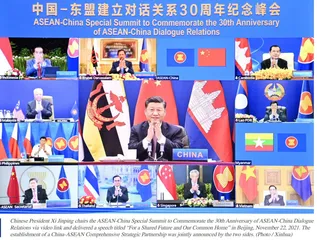The China-ASEAN Community with a Shared Future and the Reshaping of the Regional Order
作者: Lu Guangsheng

Southeast Asia is among the first regions where China initiated the building of a community with a shared future. It has been 10 years since President Xi Jinping put forward the idea of building a closer China-ASEAN community with a shared future in 2013. Indeed, this idea has become a basic principle and a vision of China and ASEAN in managing their relations. It is also the best example of China and ASEAN jointly reshaping the order of Southeast Asia and that of the Asia-Pacific region.
The China-ASEAN Community with a Shared Future Embodies the Latest Idea of China and ASEAN in Reshaping the Regional Order
The vision of building a China-ASEAN community with a shared future has been formed progressively over the period. On October 3, 2013, President Xi Jinping delivered an important speech themed “Building A Closer China-ASEAN Community with A Shared Future” to the Indonesian parliament, where the vision was first proposed and then recognized and endorsed by ASEAN countries.
On November 22, 2021, President Xi Jinping addressed the Special Summit to Commemorate the 30th Anniversary of ASEAN-China Dialogue Relations and pointed out that the development of China-ASEAN relations should center on building a China-ASEAN community with a shared future. Countries concerned should work together to build a homeland with peace, a safe and secure homeland, a prosperous homeland, a beautiful homeland, and an amicable homeland. To build these five homelands is actually a practical way to build a closer China-ASEAN community with a shared future. It also reveals the fact that the ultimate goal of building a community with a shared future for mankind is to build a homeland shared by all.
Over the past 10 years, actions to promote the building of a China-ASEAN community with a shared future have been well underway. At the bilateral level, China has been building communities with a shared future with more and more Southeast Asian countries. At the multilateral level, the Lancang-Mekong Cooperation (LMC) community with a shared future, among others, have been vigorously promoted. And the LMC community with a shared future is actually the first sub-regional one of its kind that has been officially recognized by countries concerned. At the international level, a China-ASEAN community with a shared future sets a fine example for building communities with a shared future worldwide since this community not only facilitates good neighborliness, but also plays a pioneering role in building a neighboring community with a shared future and a community with a shared future for mankind.
Looking back, various communities were proposed in Southeast Asia, most of which, however, ended up in nothing. The China-ASEAN community with a shared future, though a latecomer, has made remarkable achievements. As a vision embodies the latest idea of China and ASEAN in reshaping the regional order, it is different from the tributary system, colonialism and the treaty system. It is also distinguished from the regional order led by the US which upholds Western style of international economic cooperation and only benefits Western countries. In contrast, it demonstrates the spirit of extensive consultation, joint contribution and shared benefits. This community is a combination of China’s vision of building a community with a shared future for mankind and ASEAN’s vision of building an ASEAN community. In essence, it is the result of years of institutional cooperation between China and ASEAN.
The China-ASEAN Community with a Shared Future and the Reshaping of the Regional Order Reinforce Each Other
The China-ASEAN community with a shared future comes into being as the order of Southeast Asia and the Asia-Pacific region at large is undergoing reshaping. Such kind of reshaping includes both the increase of actors involved and changes of interactions among the actors. Regarding the increase of actors involved, many actors in Southeast Asia, including ASEAN and some other major regional powers such as China and Japan, start to have a say in shaping the regional order as the US no longer dominate the regional situation single-handly. Regarding changes of interactions among the actors, an increasing number of networks among them have been formed, making the whole region closely interconnected.
The increase of actors involved and their closer interactions have promoted the multilateralism in Southeast Asia. Indeed, a China-ASEAN community with a shared future and the reshaping of the regional order are reinforcing each other, since the community is both a product of the reshaping and a factor that reshapes the regional order.
On the one hand, the reshaping of the regional order is a precondition for the proposal of this community. The reshaping has increased the autonomy of ASEAN, which has played a balancing role in the region by continuously strengthening its integration. It is against this background that ASEAN has gradually become the new center of the region. For China, the reshaping has also accelerated the shift from a “China-centered” view to a “neighborhood-based” one. Before the end of the Cold War, the relations between China and its neighbors could be categorized into three types: the China-centered one in the ancient times, the West-centered one in the modern times, and the one with the US and the Soviet Union at the center after the end of the World War II. However, things began to change after the Cold War. China and many of its neighboring countries have gradually formed various regional communities and the China-ASEAN community with a shared future is a typical example. This community, centered on China and ASEAN countries, strives to pursue common development and is different from the old ones which were usually led by one country. Instead, it helps regional countries to determine their own destinies and the regional norms.